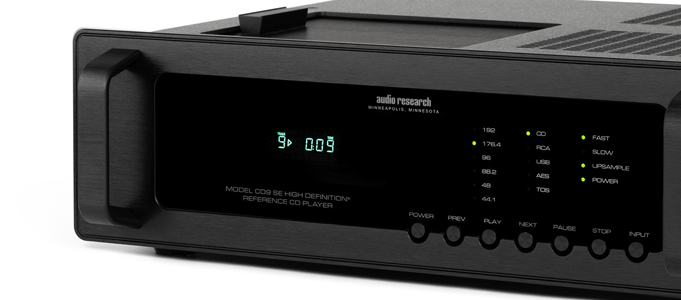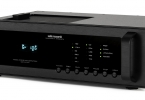AUDIO RESEARCH RELEASES SPECIAL EDITION CD PLAYERS

For reasons I just can't fathom, Audio Research's stunning CD players seem to fly under the radar compared to the 'brand's more feted valve pre and power amplifiers.
Surprising because the players are built to last a lifetime and moreover have a sound that puts them in the elite class that includes those from Esoteric and Accuphase.
Be this as it may, one thing's for sure: the newly updated REFCD9SE and CD6SE players are the components I most covet. I'd buy either or both if only I had the money to buy a ticket to their big dance.

Both are not cheap because they're not cheaply built. The REFCD9SE costs $24,995 and the CD6SE is also an eye-watering $16,995. As I said, they're not cheap for a reason.
Both are genuine high-CD players, and both have sublimely styled new faceplates that closely match those used on the brand's Foundation and Reference series models that look gorgeous.
The new look gives AR's new series of models a uniform styling. An essential feature for lucky audiophiles who can afford a stack-in-a-rack of the brand's latest models.
The most apparent difference between the two new models is valves. The REFCD9SE has them, the CDS6SE does not.
Audio Research released its first Reference Series CD player in 2005 called the CD7. I have the CD7MKII, and it serves as my high-end workhorse, but even if I had a stash to buy the new CD9SE, I'd keep my player.
The REFCD9SE mimics my CD7 in having four 6H30 vales in the output stage and one 6550WE and one 6H30 in the power supply. But where my CD7 MKII is CD only, the new flagship acknowledges that some well-heeled buyers are also into computer audio and streaming music.

The feature count is large. The REFCD9SE has four digital inputs including USB 2.O, AES/EBU, RCA and Toslink. All the inputs handle 192 kHz resolution with 16, 24 and 32-bit depths. Both units feature the brand's latest V3.0 USB audio card with a state-of-the-art FPGA design, allowing full streaming capability from products like Aurender, or Roon’s Nucleus.
Audio Research has clearly put a lot of care into this player's DAC stage, so it has Quad 24-bit DACs running in mono mode with dual master oscillators for all resolutions. Moreover, sample rate conversion is selectable for all inputs allowing for playback in native resolution or upsampling. And there's also a selectable digital filter with a choice of either fast or slow roll-off.
Audio Research players have always used a top-line Philips CD laser mechanism. This continues with both players getting the excellent Philips Pro 2 transport built into a metal sub-chassis to reduce resonance transmission. And yes, both players are top loading and use a magnetic puck to fix a disc to the spindle.
The CD6SE can be considered a stripped back REFCD9SE. It loses all the valves but has many of the top player's features. It has the same four inputs – USB, RCA, Toslink and AES/EBU. And all handle 24 bit/192 kHz resolution.

The CD6SE features all the digital updates brought by the new V3.0 USB audio card allowing for macOS, Windows 10 and Linux compatibility.
Audio Research describes the sound of both players as having a sound that's highly transparent, fast, with great transient speed, superior dynamics and endowed with terrific micro and macro dynamics.
For more information visit Audio Research.
Peter Familari
One of the veterans of the Australian HiFi industry, Peter was formerly the Audio-Video Editor of the Herald Sun for over two decades. One of the most-respected audio journalists in Australia, Peter brings his unparalleled experience and a unique story-telling ability to StereoNET.
Posted in:StereoLUX! Hi-Fi
Tags: audio research synergy audio visual
JOIN IN THE DISCUSSION
Want to share your opinion or get advice from other enthusiasts? Then head into the Message Forums where thousands of other enthusiasts are communicating on a daily basis.
CLICK HERE FOR FREE MEMBERSHIP
Trending
applause awards
Each time StereoNET reviews a product, it is considered for an Applause Award. Winning one marks it out as a design of great quality and distinction – a special product in its class, on the grounds of either performance, value for money, or usually both.
Applause Awards are personally issued by StereoNET’s global Editor-in-Chief, David Price – who has over three decades of experience reviewing hi-fi products at the highest level – after consulting with our senior editorial team. They are not automatically given with all reviews, nor can manufacturers purchase them.
The StereoNET editorial team includes some of the world’s most experienced and respected hi-fi journalists with a vast wealth of knowledge. Some have edited popular English language hi-fi magazines, and others have been senior contributors to famous audio journals stretching back to the late 1970s. And we also employ professional IT and home theatre specialists who work at the cutting edge of today’s technology.
We believe that no other online hi-fi and home cinema resource offers such expert knowledge, so when StereoNET gives an Applause Award, it is a trustworthy hallmark of quality. Receiving such an award is the prerequisite to becoming eligible for our annual Product of the Year awards, awarded only to the finest designs in their respective categories. Buyers of hi-fi, home cinema, and headphones can be sure that a StereoNET Applause Award winner is worthy of your most serious attention.







